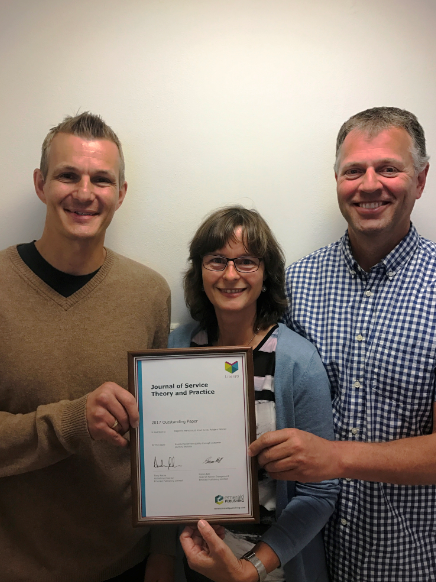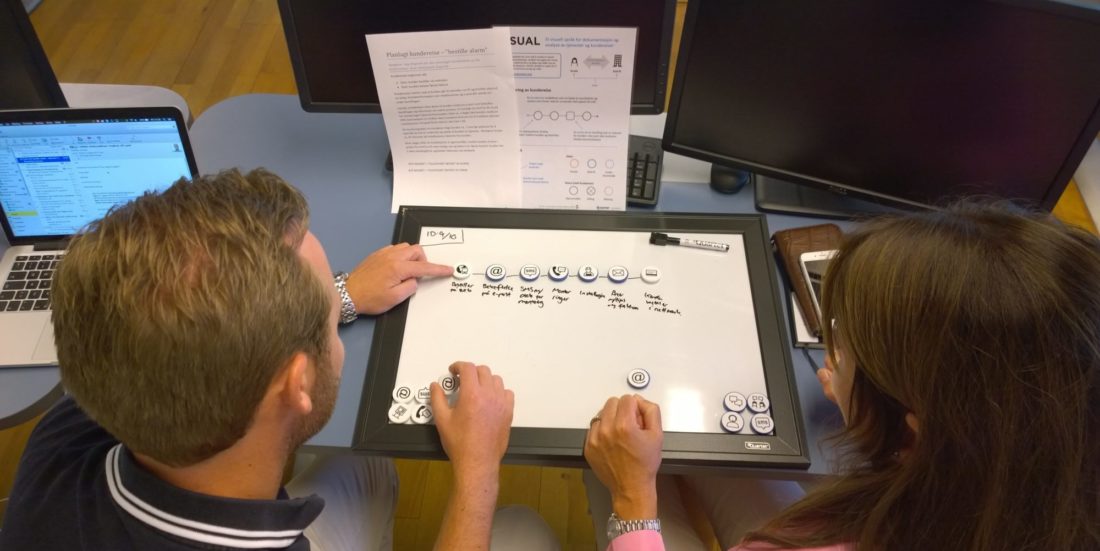Many mistakes made on Customer Journeys
“Customer journeys” have become a popular method to increase customer focus and improve service quality in many branches of industry. But research shows that the method doesn’t always work as expected – and confusion surrounds the meaning of the concept itself.

From the right: Knut Kvale (Telenor), Ragnhild Halvorsrud (SINTEF) and Asbjørn Fjølstad (SINTEF) received the “Outstanding paper of the year” award for their work on methods to improve Telenor’s services. Photo: Marita Skjuve
“We are all big-time consumers of digital services. We are our own travel agency, we submit our income tax forms by PC, and we communicate with the doctor by mobile telephones. Sometimes this works perfectly well. But in many cases, we find that the services we use are not very user-friendly, and that the transitions between web sites, emails and letters are not always logical,” says SINTEF researcher Ragnhild Halvorsrud.
A customer journey should examine the process from A to Z, and in this way help to improve digital experiences of this sort – from the perspective of the user. And this can be useful; British consumers waste an average of more than an hour a day being dissatisfied with their digital services, according to this article.
“Our research also shows that many companies do not have sufficient awareness of what their clients experience,” says Halvorsrud. In fact, none of the companies we studied were familiar with the total end-to-end customer experience.
Now, SINTEF and Telenor have developed a new analytical model of customer journeys that should ensure that the method actually uncovers unfortunate customer experiences, logical shortcomings and errors.
Researching the way to describe customer journeys
Research on customer journeys began as far back as ten years ago, when many of Telenor’s clients found the company’s digital services confusing, and put pressure on its customer service operations.
“What we found when we began to study customer journeys was that there was a lack both of precise terminology and of analytical methods for evaluating customer’s experiences across channels,” says the SINTEF researcher.
A customer journey can be complex, and may comprise many elements; for example, ordering a product over the Internet, receiving an email as a receipt for the order or a link to track the order and finally receiving a notice on your mobile to pick it up, in order to have it delivered to your door.

A customer journey consists of several steps, or “touchpoints”; this is a schematic presentation of what can go wrong. Illustration: Ragnhild Halvorsrud
The researchers concluded that both industry and academia find it difficult to precisely describe both the concept “customer journey” and the relevant methodology.
“We might say that many people use the concept as a metaphor rather than as a well-defined concept,” says Halvorsrud.
“Toolbox” development brought research recognition
Their findings led Halvorsrud and her research colleague Knut Kvale of Telenor to develop a toolbox that helps companies systematically produce good digital services.
The toolbox was given the name “The Customer Journey Framework”, and their work was recently published in the Journal of Service Theory and Practice. Their efforts ended up with the prestigious “Outstanding Paper of the Year” award.
“This just goes to show that we hit the nail on the head when we started to do research on what customer journeys really are, how they are used, and whether they really work,” says the SINTEF researcher.
What is supposed to happen, doesn’t happen
According to the researchers, the essence of the customer journey work is to distinguish between plans and what actually happens in real life. With more and more digital channels coming into use, a planned customer journey can be carried out in a number of ways; from a PC, mobile phone, tablet or via SMS. This turns the provision of good information with logical transitions into a major challenge for a company. On top of this, it is essential to balance the objective factors in the service such as who, what and where, against the individual user’s experience of each individual step; i.e. all the way from when a customer logs in to a web-site to when the service has been supplied and tested by her.
“Our experience is that most customers experiences deviations in their customer journeys. None of the companies that we studied had a complete overview of their client journeys. Many of them were familiar with most of the process, but detailed insight into all of the stages that their clients might encounter was lacking,” says Halvorsrud.
Lack of research in this field
In the course of several projects, the researchers collaborated with consultants and public- and private-sector service providers, as well as with other researchers. They also studied the relevant scientific literature in depth.
“There is not a great deal of previous research on customer journeys, but there exists quite a lot of relevant research in related fields. We have built up a solid catalogue of data derived from practical case studies with Telenor and other companies,” says Halvorsrud.
Some of the findings of the project were that:
- None of the companies were familiar with the entire customer journey from A to Z. Knowledge was spread among several departments, none of which had the whole picture. (Known as the “silo effect”.)
- All real-life customer journeys deviated from the journey as planned by the company. Most of them had several deviations; for example, a customer would need to contact the customer service department, or a letter containing critical information did not reach the customer in time.
- There was often a pattern in the deviations, such as that things happened in the wrong order, or that a particular stage in the process created confusion.
- There were several illogical transitions or handovers in the course of the journey, for example a lack of consistency between a web-site and a letter that a customer received from the company.
Researchers created a methodology for revealing weaknesses
The researchers decided to establish a “best practice” and a method for quality-assuring customer journeys. The method was given the name of Customer Journey Analysis.
“Our aims is to “dissect” the planned customer journey and map the customer’s experience at individual level. This will make it a simple matter to reveal weaknesses, so that they can be corrected,” explains Halvorsrud.
If you would like to find out more about customer journeys you can check out the following articles:





